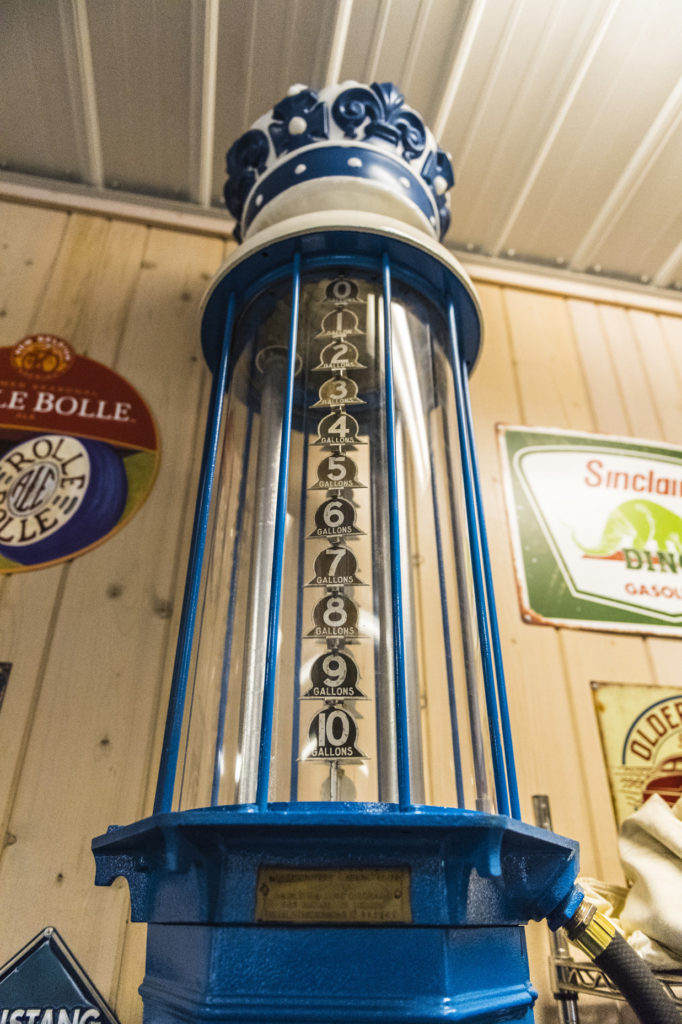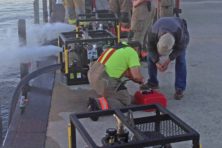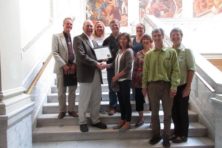Pumping Life Into the Roadside: Don Koepsel Adds New Fuel to Historic Local Gas Pumps
- Share
- Tweet
- Pin
- Share

Don Koepsel’s barn across the street from the farmhouse in which he grew up would be described by some as an art gallery. Historic gas pumps stand like vibrant statues against a backdrop of vintage metal signs hanging on the wall. The retired insurance agent needed something to do with his time and it turned out the county was littered with these historic pumps that were once in full service at the oldest businesses on the peninsula.
“Everybody used to have gas pumps out in front,” Koepsel said, naming the Greenwood Supper Club and the AC Tap as just a few of the local spots to refuel 60 years ago.
He pointed to two pumps in his workshop. One is rusted into four pieces with the shell next to it, a dusty extension cord tangled on top. The other gleams a bright and glossy red with a bulb above it, shining like a beacon for Texaco’s premium Sky Chief gasoline. Half a century ago, they stood side by side.
“These pumps were taken down probably 40 years ago and they were laying behind a shed there by the Greenwood,” Koepsel said. That is the explanation for most of the old gas pumps he comes across.
“My friend Greg Thoma had this blue one,” Koepsel said, pointing to a Standard Oil Company pump brushing the ceiling of his workshop, nearly 10 feet high. “It was just a rusted piece of junk in his shed. We got over there and tore it apart, cleaned it up and painted it.”

This visible gas pump was the first Don Koepsel restored. As gas is pumped up into the clear cylinder with a crank, the numbers indicate how many gallons you will put into your car.
Koepsel wasn’t sure where that project would lead, but he has now refurbished eight old gas station pumps, either delivered to him or scavenged from throughout the state.
“It’s interesting tearing them down and just seeing how these things work,” Koepsel said, showing his love for machinery born in his farming youth. “The engineering is really fantastic in some of these. It’s not electric, not computerized.”
The most fantastic of those engineering ideas is in a type of pump called “visibles.”
Visible gas pumps have a large glass cylinder on top of them. The cylinder is marked with numbers spaced evenly from top to bottom. A long crank arm sits waist-high toward the bottom.
After pulling your 1926 Chrysler Imperial or your 1936 Buick Limited (Koepsel estimates this gas pump was erected between 1926 and 1930), you would crank the arm like a water well. Gasoline would be pumped up to the glass chamber above your head with each number marking the gallons. After placing the nozzle of the pump in your car, gravity sucks the cylinder dry, filling your tank.
Koepsel’s restored pumps don’t come with all of the mechanics inside, which would add too much weight to haul them across the state, but looking at the shiny sheen from the outside, it would be impossible to tell.
So far, Koepsel has only restored and sold gas pumps for people he knows, but a trip to northern Wisconsin later this year to meet a man who collects them may bring in more work for the retiree.
“It keeps me busy,” Koepsel said, who barely squeezed in time for this interview between his work with the late summer cherry harvest. “I have a place to work here in the winter time and I can work whenever I want. I can’t sit around.”
But it’s not just the boredom of retirement or love for these machines that sends him scavenging into junkyards looking for old auto paraphernalia to restore.
“The way I look at it, someone has to save our history,” Koepsel said. “We’ve got some great historical societies and they are trying to bring back the past and they’re doing a great job. This is my way to do that.”
While most of his refurbished gas pumps go to private owners, Koepsel has gotten some interest from local businesses looking to bring back the history that likely stood outside their front doors decades ago.
“You can’t just go so far,” Koepsel said. “You think, ‘As long as we’re this far, I might as well do that too.’ You keep doing that and it adds up.”
 It starts with sandblasting the rusted metal to smooth its weathered surface. Then he primes and paints the metal whatever color a customer wants. When these pumps were first built, the oil companies were the customers.
It starts with sandblasting the rusted metal to smooth its weathered surface. Then he primes and paints the metal whatever color a customer wants. When these pumps were first built, the oil companies were the customers.
“Say if Standard or Mobil wanted a bunch of pumps,” Koepsel said. “I could take that pump and, once I get it sandblasted and painted, I can put whatever decals or paint it whatever color you would want as a customer because that’s what these companies would do.”
Koepsel pulled up the rusted, unfinished piece that used to stand in front of the Greenwood Supper Club and places it on his workshop table. It’s another fresh metal canvas, each one bringing different challenges and different history.
“You keep going until it looks good,” Koepsel said above the soft sound of doo-wop and static coming out of the radio.
He ran his hand over the front, examining the holes that he will have to cover up. He explained how the doors would often be dented as people kicked them closed because they would never quite close right.
This one is in pretty good shape.



